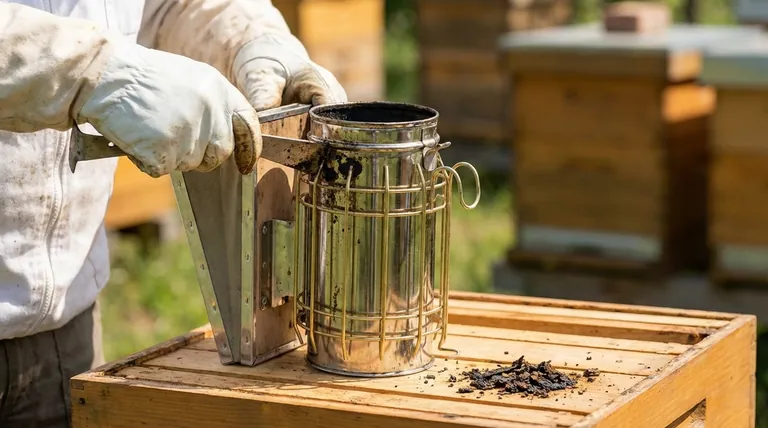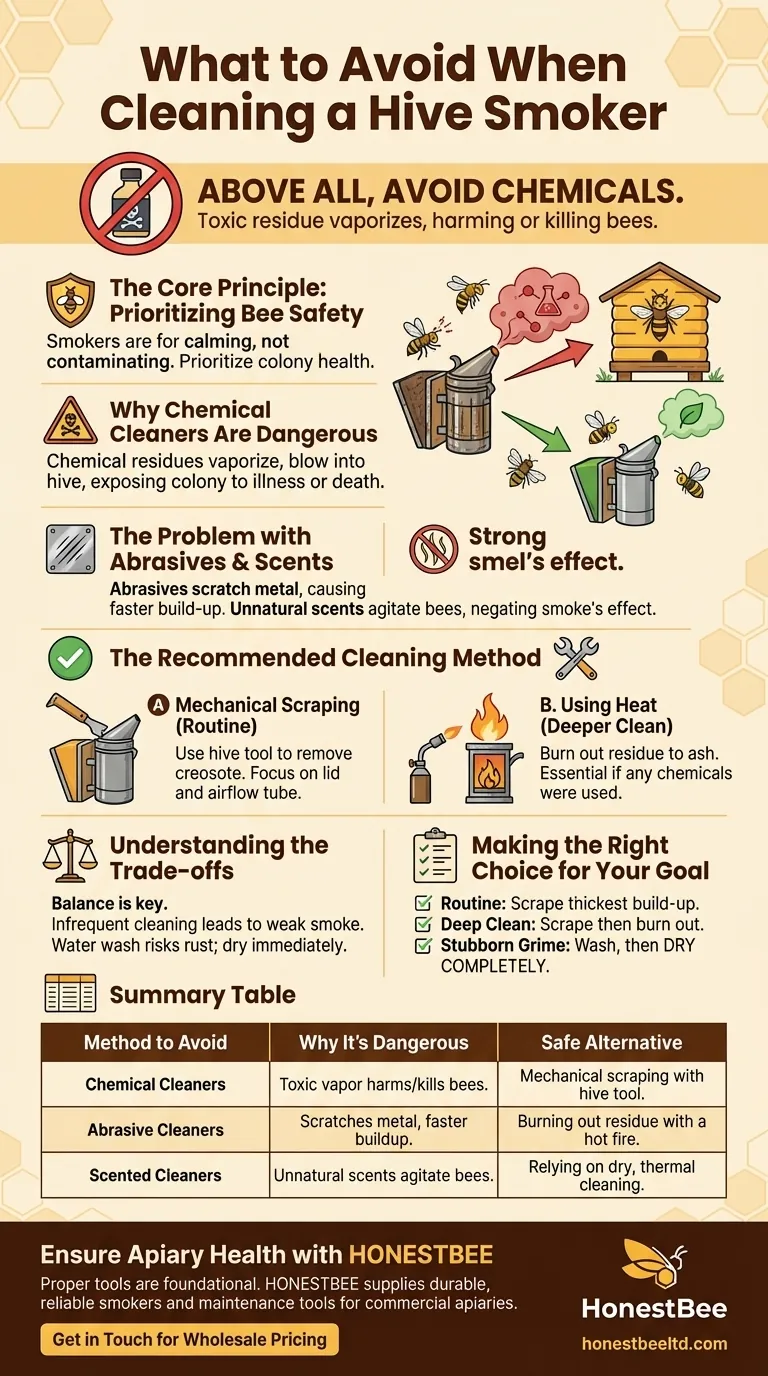Above all, avoid chemicals. When cleaning a hive smoker, the most critical thing to avoid is any abrasive or chemical cleaner that contains toxic materials. Residue from these products can linger inside the smoker, becoming aerosolized in the smoke during your next hive inspection and potentially harming or killing your bees.
The safest and most effective way to maintain a hive smoker is to rely on mechanical and thermal cleaning—scraping out buildup and occasionally burning it clean—rather than introducing potentially hazardous chemical agents into the bees' environment.

The Core Principle: Prioritizing Bee Safety
Your smoker is a tool for calming your bees, not for introducing foreign or toxic substances into their home. Every cleaning decision must prioritize the health and safety of the colony.
Why Chemical Cleaners Are So Dangerous
Chemicals that seem harmless in a kitchen sink can be incredibly toxic to bees. When you light your smoker, any leftover residue from a cleaning agent will vaporize and mix with the smoke.
This contaminated smoke then blows directly into the hive, exposing the entire colony to substances that can cause agitation, illness, or death.
The Problem with Abrasives and Scents
Even non-toxic or "natural" cleaners can be problematic. Abrasive cleaners can scratch the metal, creating areas where creosote builds up faster in the future.
Furthermore, any strong, unnatural scent left behind can be alarming to the bees, potentially negating the calming effect of the smoke and making your inspections more difficult.
The Recommended Cleaning Method
The professional standard for smoker cleaning avoids chemicals entirely. The process relies on simple mechanical removal and heat.
Mechanical Scraping for Routine Maintenance
For regular upkeep, a standard hive tool is your best friend. Use it to scrape the thick layers of creosote and soot from the inside walls of the smoker canister.
Pay special attention to the upper section of the canister and the inside of the lid, as this is where most of the sooty buildup collects. Also, ensure the airflow hole or tube is clear of debris.
Using Heat for a Deeper Clean
For a more thorough cleaning, you can burn the residue out. After scraping out the loose material, light a small, hot fire inside the smoker and let it burn for an extended period.
This will incinerate the stubborn, baked-on creosote, turning it into a brittle ash that can be easily brushed out once the smoker has cooled completely. This is also the required final step if any cleaning product was ever used, as it's the only way to be certain you've burned off residual chemicals.
Understanding the Trade-offs
Proper smoker maintenance is a balance. While avoiding chemicals is paramount, neglecting your smoker entirely creates its own set of problems.
The Cost of Infrequent Cleaning
A heavily clogged smoker is difficult to light and keep lit. It produces weak, inconsistent smoke, which makes hive management more stressful for both you and the bees.
A clean smoker allows for better airflow, producing the cool, white smoke that is most effective for calming a colony.
The Risk of Using Water
While a thorough annual wash is acceptable, be cautious. If you wash your smoker with water, it must be dried immediately and completely to prevent rust.
For this reason, many beekeepers prefer to stick to a dry-scraping and burn-out method, which achieves a deep clean without introducing the risk of corrosion.
Making the Right Choice for Your Goal
Your cleaning approach can be tailored to the smoker's condition and your available time.
- If your primary focus is quick, routine maintenance: Use your hive tool to scrape out the thickest soot build-up and ensure the air tube is clear.
- If your primary focus is an annual deep clean: Scrape the canister thoroughly, then use a propane torch or a hot fire to burn out any remaining residue until it turns to ash.
- If you must use water to remove stubborn grime: Wash the components, but be absolutely certain to dry them completely, using heat if necessary, to prevent rust.
Proper smoker maintenance is a simple task that directly contributes to the well-being of your bees and the efficiency of your work.
Summary Table:
| Method to Avoid | Why It's Dangerous | Safe Alternative |
|---|---|---|
| Chemical Cleaners | Toxic residue can vaporize and harm/kill bees. | Mechanical scraping with a hive tool. |
| Abrasive Cleaners | Scratches metal, leading to faster creosote buildup. | Burning out residue with a hot fire. |
| Scented Cleaners | Unnatural scents can agitate bees. | Relying on dry, thermal cleaning methods. |
Ensure the health of your apiary with professional-grade equipment from HONESTBEE.
Proper tools are the foundation of safe and successful beekeeping. A well-maintained smoker is crucial for colony health. At HONESTBEE, we supply commercial apiaries and beekeeping equipment distributors with durable, reliable smokers and maintenance tools designed for heavy use.
Let us help you protect your investment and your bees. Contact our wholesale experts today to discuss your equipment needs and discover how our products can enhance the efficiency and safety of your operations.
Get in Touch for Wholesale Pricing
Visual Guide

Related Products
- Stainless Steel Bee Hive Smoker Beekeeping Smoker for Wholesale
- European Stainless Steel Bee Smoker for Honey Bee Hive
- Stainless Steel Electric Beehive Smoker for Beekeeping and Bee Keeper Use
- Stainless Steel Honey Bee Smoker Hive and Honeycomb Smoker for Beekeeping
- Premium Traditional Copper Bee Smoker with Bellows
People Also Ask
- What are the two most important beekeeping tools? Master Hive Inspections with Smoker & Hive Tool
- What supplies are needed to prepare and light a bee smoker? Master the Art of Calm Hive Inspections
- Is a bee smoker necessary? The Essential Tool for Safe and Effective Hive Management
- Why do beekeepers use smoke in their hives? Master Beehive Communication and Safety
- Are bees bothered by smoke? The Beekeeper's Secret to a Calm Hive



















